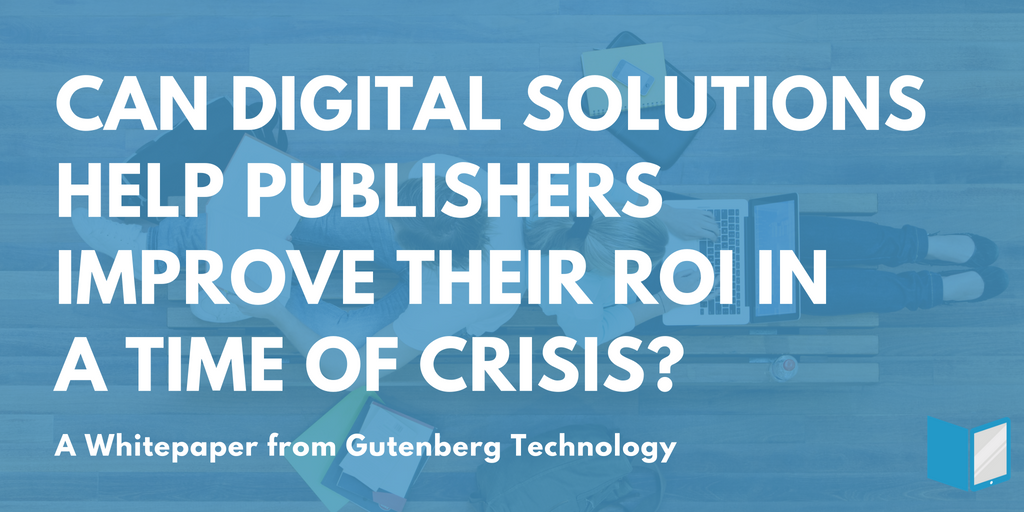The leading global academic publishers have reported dramatically diminishing sales of printed textbooks which have led not only to hugely reduced profits but also increasing losses – billions of dollars for some. Faced with a powerful digital content revolution and growth of an industry that supports digital publishing technology, it is clear that digital solutions are the answer when it comes to improving return on investment (ROI) in this time of crisis.
But it’s not that simple.
Digitization of books has evolved rapidly in recent years, from the software used to produce electronic textbooks, to delivery channels, and fee models. It has also opened up opportunities to add visual, audio, and various teaching resources to books that may be accessed both online and via an abundance of different digital reading devices.
Financial pressures have forced most publishers on a digital road. But many still conform to the print first philosophy, following traditional workflows and technologies for print, that are also used to produce digital publications, but which take a lot longer from ideation to delivery. While this approach impacts directly on costs, largely because of overlapping timelines and a number of redundancies, it is not the only financial issue academic publishers are grappling with. They certainly have to cut costs wherever they can, without compromising the quality of either content or presentation. But publishers also need viable fee structures that work for them and the students who are going to buy their textbooks and other learning materials.
As the current digital content revolution continues to gain traction and disrupt the traditional publishing establishment, the concept of Netflix-type flat fees for digital textbooks is transforming the industry.
Gutenberg Technology’s new white paper, Flat Fees for Digital Textbooks Set to Revolutionize Academic Publishing, examines all these issues, concluding that an equitable flat-fee structure for digital textbooks is set to revolutionize academic publishing.
Challenges of Fee Structures for Digital Textbooks
As the white paper points out, the idea of flat fee models for digital content is not new, rather it is the way flat fee models are being devised and developed to help improve ROI that is changing.
The reality is that the sales of printed textbooks have been declining for years. Students need them, but many prefer to either buy secondhand books or to lease new ones. A growing number search for online resources that will provide further information on course topics they can add to lecture material. But it does seem that the idea of digital textbooks combined with added extras is one that students, in general, are embracing.
While the Gutenberg Technology white paper looks historically at fee structures, including flat fees, and various subscription ideas, it is the contemporary approach that is important.
Some of the textbook publishers that have been charging some kind of flat fee include Pearson Plc, Rafter, and Cengage. A number of publishers make both printed and digital textbooks available according to various fee structures.
The Cengage payment model, due for launch in August 2018, is the most progressive of its type. It is a flat-fee model that follows the profitable trend set by Netflix for movies and TV series and will allow students to access unlimited course materials on demand, the time period depending on the subscription they choose. Positioning itself as a “catalyst for change”, the company, an undisputed leader in the traditional textbook publishing industry, plans to have a 90 percent-digital operation by 2019.
The UK-based Perlego also offers a flat fee that is based on the Netflix model. The main difference is that they provide content from various publishers to university and college libraries. Publishers include Pearson, McGraw-Hill, Wiley, and Palgrave, all of which get paid depending on usage of their books.
Nevertheless, as the white paper acknowledges, there is still a real demand for printed textbooks. The challenge for academic publishers embracing the traditional print approach combined with digital products is to make certain that the two workflows integrate in a way that will minimize overall timelines, and ultimately maximize profits.
A remarkable simple software solution comes in the form of Gutenberg Technology’s MyEcontentFactory (MEF) that enable publishers to focus on a digital-first process that works seamlessly with the print option that follows.
More than 20 educational companies and publishers are using MEF software already, including Cengage Learning.






Leave a comment